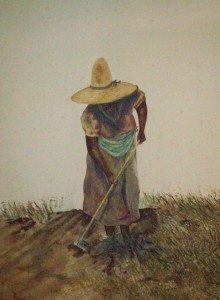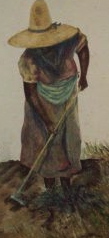
In his painting, Woman in the Field, artist Richard D. Burton used masking as well as layering in his wet-on-dry watercolor style painting. He explains his technique here for the viewers of Art Center Information.
To prepare the painting and create the background midday sky, I used a weak wash of yellow ochre over the entire 20″X28″ Arches 300 (cold press) paper. After letting it set for 48 hours I turned it upside down and super imposed a similarly weak wash of rose madder and waited another 48 hours. Then I turned it back up and laid a weak wash of cobalt blue.
My compositional drawing was then done by copying over a sketch made of the figure of the female. Although I had done a complete drawing showing the high grass, weeds and growth, I did not use this on the prepared watercolor paper, choosing to allow my painting a sense of freedom in contrast and suggesting action to the more staid female figure.

After sketching the composition on the paper’s surface, I laid up a wash of yellow ochre creating the base for the ground area. After this dried, I took a brush filled with Windsor & Newton Water Colour Art Masking Fluid and flicked and stroked throughout the ground creating a loose high grass effect. I did this to create areas of lighter grass that will later contrast with the darker ground and green grasses.
I then covered the ground with superimposed washes of darker ground color mixtures. Over this I painted in various hues of green. Then I scraped away the dried masking fluids, giving a lighter variation of grasses.

Probably, one of my greatest challenges was to paint the dress on the figure. In my minds eye, I could see an old pinkish dress (to contrast with the greens in the grass) that was well worn, dirty, and more than likely her favorite clothes while working in the garden. Whether I accomplished this effect or not, I don’t know – the jury is still out. However, I satisfied myself enough to say enough is enough.
To accomplish my challenge, I had to do several layers of color over each other. I always give a watercolor-style painting 48 hours before washing over it with another color. The colors used was a rose madder and a mixture of rose madder and green which created a neutral gray. I also did some scraping on the overly washes which gave the dress the well used and aged effect.
Although I did not use the masking fluid directly on the white paper, I often do when the white of the paper’s surface serves as the lightest value in my paintings. Masking is especially helpful for preserving small, complex parts of a composition that would be near impossible to paint around.
It is a happy moment when we artists can create the effect we wish to accomplish when we are able to paint a watercolor picture using only one layer of paint; however, most pictures will require some areas of multiple layers. The most practiced layering sequences in transparent watercolor method of painting is to wash dark hues over light ones. I particularly like it when I can layer transparent washes of similar values one over the other. The end result of the newly created hue is usually stunning, and it is much better than trying to mix the colors to create the same effect.
Be sure to sign up for the Art Center Information newsletter and enter the drawing to win a free coffee table art book>>>Upper right hand corner of page.
